The Appalachian Pipeline Resistance Movement: “We’re Not Going Away”
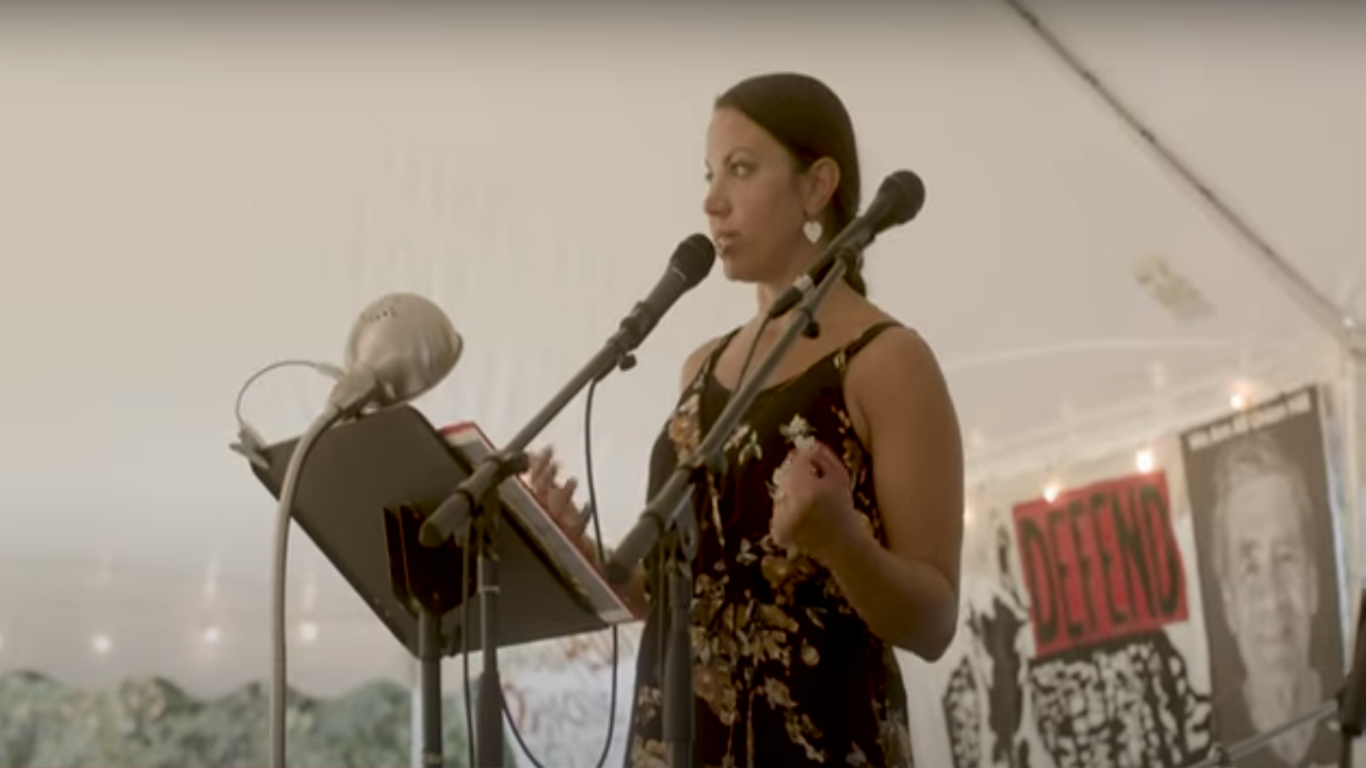
Desiree Shelley, who is Monacan, is an organizer with Mothers Out Front. Here, Shelley is speaking at the Circle of Protection: Bent Mountain event in September 2019. Photo courtesy of Desiree Shelley
The six-year fight against the Mountain Valley Pipeline has left its mark on communities all along the project’s roughly 303-mile route. Some of these marks are physical — a vertical scar of felled trees up steep mountainsides, sections of pipe laid next to mounds of dirt — but others are more subtle.
“There’s a lot of mixed emotions, good and bad,” says Greenville, West Virginia, resident Maury Johnson, whose farm is in the path of the pipeline. “There’s a lot of people that I was very close to that I probably won’t be close to again, there’s people that I didn’t know four years ago that I consider to be close family now.
“When you go through something soul-searching like this, you find people that you just think the world of that you didn’t know a year ago.”
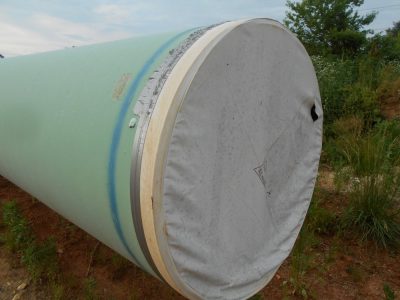
This section of the Mountain Valley Pipeline had been exposed to the elements in Franklin County, Va., for nearly a year at the time this picture was taken in May 2019. Photo by Anne Way Bernard
In July, Dominion Energy and Duke Energy canceled the roughly 600-mile Atlantic Coast Pipeline, which also faced strong and persistent opposition and had been mired in ballooning costs and legal uncertainty for years. The Mountain Valley Pipeline and its 73-mile extension into North Carolina, MVP Southgate, face similar obstacles and a groundswell of grassroots resistance.
The resistance movement against the Atlantic Coast and Mountain Valley pipelines has taken many forms. Residents in the path of these projects have made their voices heard at government meetings near and far, formed community groups, submitted public comments on permit decisions, monitored construction, established tree-sits and other protests on pipeline work sites, and more. With the momentum from the defeat of the ACP, many residents in Mountain Valley’s path hope the end of the fracked-gas behemoth is near.
Building a Network
Discourse surrounding the MVP has split many communities into two camps: those who support the pipeline and hope it will bring jobs, and those fighting against it.
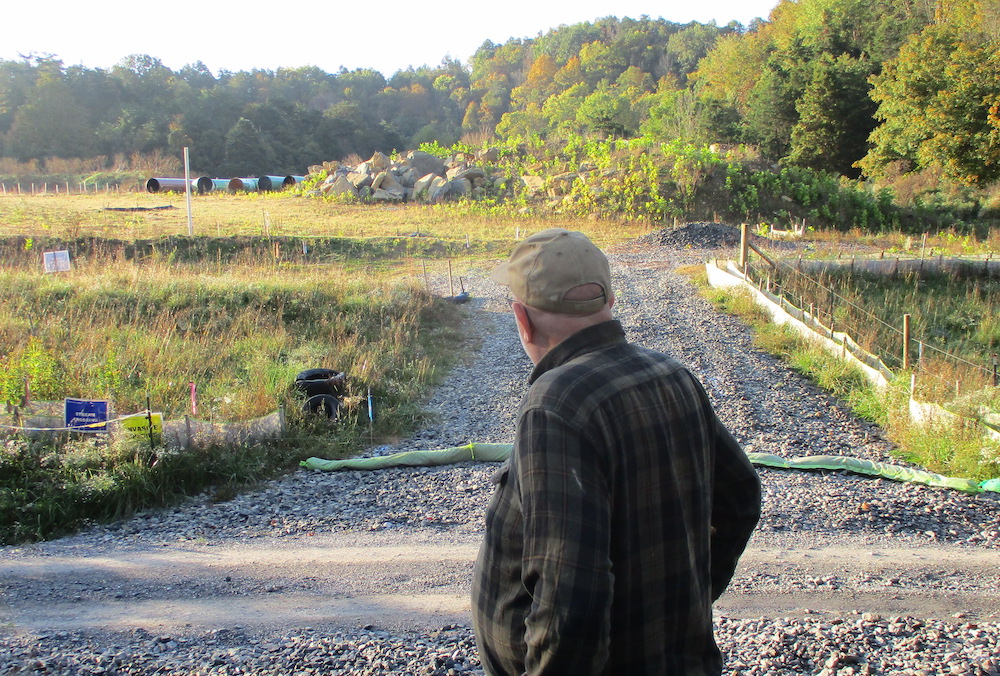
Greenville, W.Va., resident Maury Johnson stands near a Mountain Valley Pipeline crossing in Monroe County, W.Va., on Oct. 1. Photo by Paula Mann
In Monroe County, West Virginia, Becky Crabtree sees a similar situation.
“It has damaged the relationships in some neighbors and some people who attend the same church,” says Crabtree. “There’s a clear line between those who are for it and those against it, and both groups are passionate.”
Crabtree is firmly against the project; the pipeline cuts through the portion of her property where her youngest daughter had planned to build a house. She states that she has made new connections in her county through the fight against the pipeline.
“There are people who have given money and time and cooking and PR and legal documents — so many good people who have come together to fight it in a variety of ways,” says Crabtree. “You just don’t know what somebody is able to give until you ask them.”
Soon after construction began on the MVP, Johnson and Crabtree were among those who formed Mountain Valley Watch, a volunteer-driven effort to document environmental violations committed by pipeline builders. As of Oct. 28, water quality monitors have reported 650 potential construction and erosion control violations.
“I would say more than 100 people have filed complaints [in West Virginia alone],” says Johnson. “Some people have only filed one or two complaints; some, like me, have filed 182.”
At times, some volunteers would spend 20 or more hours a week monitoring the route, according to Johnson. Mountain Valley Watch conducts regular flyovers to get a bird’s-eye view of construction.
“I have destroyed about 10 point-and-shoot cameras over this whole ordeal,” says Johnson. “I take about 35,000 pictures a year with these cameras till they wear out.”
Behind Mountain Valley Watch is a coalition of 15 community advocacy groups called POWHR: Protect Our Water, Heritage, Rights. In Floyd, Virginia, Preserve Floyd co-founder Mara Robbins found out that the pipeline was slated to go through Floyd County in July 2014. Preserve Floyd is part of POWHR.
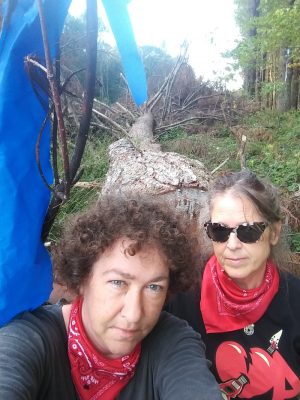
Mara Robbins, left, and fellow activist Tammy Belinsky while installing water flags along the MVP easement near Bottom Creek in Bent Mountain, Va., in October 2018. Photo by Mara Robbins
“Long before they had any right to survey or anything, [pipeline investors] were already harassing residents,” she continues. “So we formed a group, Preserve Floyd, within a couple of weeks. We had 127 people at our first community meeting, and by the middle of August, we had 14 active working groups.”
“There were a lot of people who knew what they were doing already, especially landowners,” she continues. “I was suddenly at the hub of a very big wheel because I said ‘no.’”
Floyd County has a history of pushing back against large infrastructure projects. Robbins’ father organized the first Citizens for the Preservation of Floyd County in the 1980s in response to proposed utility transmission towers. While that battle was lost, residents helped to fight off Dominion Energy’s Greenbrier Pipeline in the mid-2000s. In October 2014, MVP developers shifted the pipeline’s route north to Roanoke County, avoiding Floyd County entirely. Robbins and others with Preserve Floyd continue to work against the MVP in solidarity.
“We’re not going away. We have stuck this out. Really, we only have to fight one day longer than they do.” — Mara Robbins
Indigenous Resistance
In 2014, a group of ranchers, farmers and tribal communities known as the Cowboys and Indians Alliance planted seeds of sacred Ponca corn in Nebraska on land that was both in the path of the embattled Keystone XL pipeline and the Ponca Trail of Tears. Two years later, this “Seeds of Resistance” tour visited communities like Stuarts Draft, Virginia, along the routes of the Atlantic Coast and Mountain Valley pipelines to plant more Ponca seeds.
“Growing up the daughter of a farmer, I was taught to respect the land,” Stuarts Draft, Virginia, resident Virginia Davis told Bold Nebraska in 2016. “[Atlantic Coast Pipeline developer Dominion Energy] disrespects our land, our communities, and our great Augusta County. I can think of no better way to pay respect to our land than to plant the sacred corn that the Ponca have shared with us in the proposed path of this incredibly destructive pipeline.”

Desiree Shelley and her daughter Tuhawiyani at the Climate Emergency: Tri-State Pipeline Strike in Roanoke, Va., in September 2019. Photo courtesy of Desiree Shelley
“Less than a year later, they started construction of the pipeline,” says Shelley.
She states that when there’s a heavy rain, she can see the sedimentation draining into the headwaters of the Roanoke River — the drinking water source for the city of Roanoke, Virginia.
“I can drive along the road and I can see the stream overflowing, and the damage that it’s doing to people’s farms,” says Shelley. I can just see how brown the water is.”
For several years, Shelley has been involved with the Indigenous-led water protector movement, which gained national recognition in 2016 during the Dakota Access Pipeline protests on the Standing Rock Indian Reservation. Shortly after the MVP began construction, she learned the extent to which that pipeline would impact Indigenous sites.
“I knew that this was going through a lot of our traditional territory, and that was upsetting,” says Shelley. “But I did not know exactly what was along the route because a lot of it is on private land, and a lot of our Indigenous groups and communities have not been able to access any of that land for a couple hundred years now.”
Burial Mounds
For large infrastructure projects like pipelines and highways, federal law requires developers to survey for archaeological sites along the route. In one Southwest Virginia community, Mountain Valley Pipeline registered three separate places as historic Indigenous sites.
“MVP sent in a team of consultants who set up camp on [one site on] private land and cleaned out all the Native American artifacts from that area, removed them from the ground, where they had been left there for hundreds of years,” says Ann Rogers with the nonprofit environmental organization Blue Ridge Environmental Defense League. “That’s a really, really inappropriate treatment modality for Native American sites.”
In MVP’s 2017 Final Environmental Impact Statement, the company identified 50 Indigenous cultural sites. Out of these, the company only classified one as a burial mound, located in Nicholas, West Virginia. Desiree Shelley states that this is inaccurate, and that there are several burial mounds and other Indigenous cultural sites either in the pipeline’s path in Southwest Virginia or close enough to be affected by construction.
“These burial mounds are considered to be sacred sites,” says Shelley. “In many cases, mounds were constructed near waterways. They were considered a sacred and ceremonial site where people would return year after year as a way of connecting with their ancestors to honor them.”
Ann Rogers states that Rosebud Sioux Tribe Tribal Historic Preservation Officer Ben Rhodd identified a burial mound on private land in Southwest Virginia in the spring of 2018. Rhodd and the tribal historic preservation officer from the Cheyenne River Sioux Tribe had been brought to the site by grassroots group Preserve Franklin and the Blue Ridge Environmental Defense League. Desiree Shelley states that the archaeological survey team found as many as six other burial mounds in the surrounding area along the pipeline’s route.
The landowner informed FERC of the site shortly after the team visited. But when MVP sent in surveyors to examine the location, they concluded that it was a “push pile,” a remnant of White settlers’ farming activities, according to Rogers.
Later in 2018, BREDL and the cultural preservation officers from the Cheyenne River Sioux Tribe and the Rosebud Sioux Tribe sued FERC for failing to satisfy the requirements of the National Historic Preservation Act. One of the group’s concerns was FERC’s refusal to consult with the Sioux Tribal Historic Preservation Officers. But a federal court threw out the case and several others related to pipeline opposition in February 2019.
Mara Robbins explains that Mountain Valley shifted the route of the pipeline to avoid the site that Indigenous experts say is a burial mound but that the developer maintains is a “push pile.” But now, the route is uphill of the site.
“If they cleared those trees, the first big storm would just wash [the mound] into the creek because of their pathetic attempts at erosion control,” says Robbins.
Some of the artifacts uncovered by archaeologists near these sites date back to 10,000 years.
“These very old artifacts found near our burial mounds can help us learn and understand a lot more about our history in this region,” wrote Shelley in an email. “The fact that there are 10,000-year-old artifacts as well as more recent items suggests that our ancestors had a continual presence in this area and a long-term commitment to the ancestors and the land. It is incredibly useful for our community to have the opportunity to better understand this history. This helps efforts of cultural revitalization after a long history of colonization in Virginia.”
Shelley states that much of Monacan history and traditions has been erased over the years. Sites like these burial mounds are important pieces of the puzzle in reclaiming that knowledge.
“Within Virginia, there hasn’t necessarily been a respect or a concern for protecting Native American sacred sites in the same way as there has been for protecting something like Civil War or colonial sites,” wrote Shelley in an email.
Making Connections

Signs from the September Climate Emergency Tri-State Pipeline Strike in Roanoke, Va. Photo by Lara Mack
After pushing for the ACP since at least 2014, lead developers Dominion Energy and Duke Energy finally canceled the project on July 5, 2020 due to ever-increasing costs and legal uncertainties. The pipeline was slated to send fracked gas from the hills of West Virginia all the way to southern North Carolina. Compressor stations like the one planned for the majority African-American community of Union Hill in Buckingham County would have been used to pump gas through the pipeline, emitting air pollutants and loud noise 24/7.
[ Read more about the factors that led to the end of the Atlantic Coast Pipeline ]
All three of the ACP compressor stations were set to be built in communities below the national poverty line: Buckingham County, Virginia, Lewis County, West Virginia, and Northampton County, North Carolina. Like Union Hill, Northampton County is a predominantly Black community.
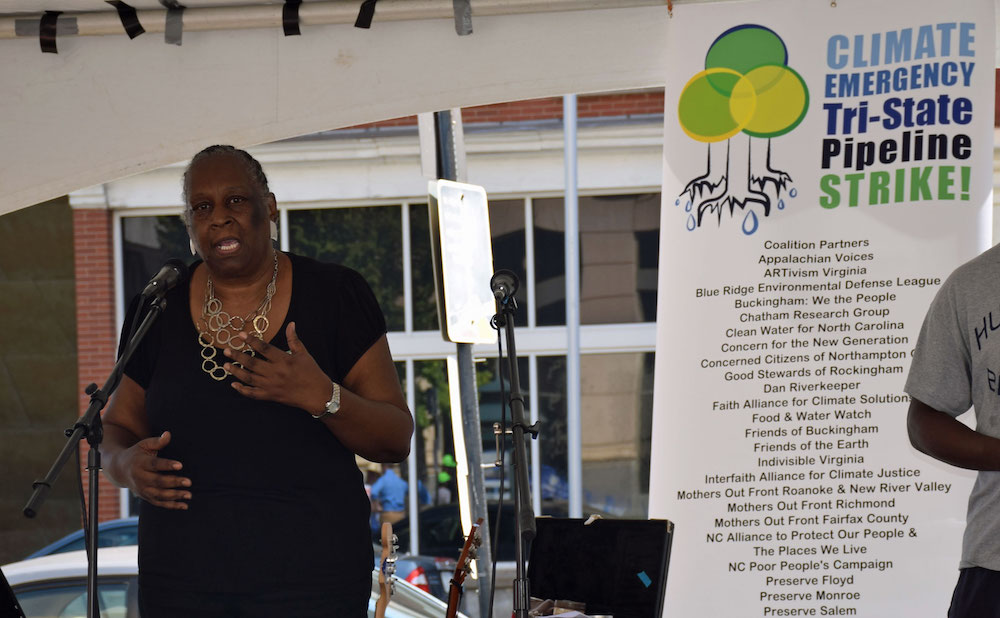
Northampton County, N.C., resident Belinda Joyner speaks at the Climate Emergency: Tri-State Pipeline Strike in Roanoke, Va., in September 2019. Photo provided
Desiree Shelley states that pipeline companies often target marginalized populations such as Indigenous, minority and low-income communities.
“They feel these communities don’t have a political voice, don’t have wealth, don’t have ways and resources to fight it,” says Shelley. “If you site something in a wealthy neighborhood, there will be enough pushback and political pressure that it won’t be easy. But when you are in a poor community or one that’s been marginalized, you possibly have so many other things that you are fighting that you just don’t have the time or energy to fight it.”
Appalachian Voices, the nonprofit organization which produces this publication, joined together with 50 other groups in the Mid-Atlantic region to form the Allegheny-Blue Ridge Alliance in 2014. Participants in the alliance gathered important information for the public, communicated with public officials and coordinated large parts of the resistance movement against the fracked-gas pipeline.
“We hosted community meetings, developed citizen fact sheets and talking points, spoke at public hearings, submitted numerous comments on various permits, appealed illegal permits, met with agency heads, conducted field tours with decision-makers, and provided technical assistance to impacted landowners and allied groups,” Angie Rossier of Allegheny-Blue Ridge Alliance member group West Virginia Rivers said in a statement.
West Virginia Rivers also worked with the fisheries conservation group Trout Unlimited to develop a pipeline water quality monitoring program, which Appalachian Voices helped to facilitate. The organizations trained more than 500 volunteers on how to assess water quality damage, identify pipeline construction violations and how to properly report these issues.
MVP Southgate
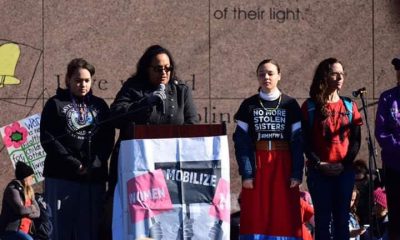
Crystal Cavalier-Keck, an Occaneechi-Saponi Tribe citizen and resident of Alamance County, N.C., speaks at the Raleigh Women’s March in January 2020. Photo courtesy of Crystal Cavalier-Keck
“It was so quiet, nobody was talking about it,” says Cavalier-Keck. “When I brought it up to our tribal council, they were unaware of it. I was like, ‘Oh my god, this is horrible. We need to contact somebody.’”
So she began to reach out to the Sierra Club and other environmental organizations.
“I’ve worked with the Sierra Club and the Haw River Assembly to, one, understand what MVP Southgate was, and why was it coming through here, and just working with people in the community to educate them,” says Cavalier-Keck. “People don’t understand the danger until they know it’s a danger.
“When I looked through all of those pages of documents that [MVP Southgate] sent, I didn’t see anything that would benefit the people where we live,” she continues. “I just thought it was a passthrough, just using our land to go somewhere else.”
Cavalier-Keck connected with Desiree Shelley. After Duke and Dominion canceled the Atlantic Coast Pipeline, Cavalier-Keck and Shelley seized the moment and reached out to several organizations and to hold the Indigenous-led No MVP Virtual Rally on July 25 to bring more attention to the impacts that MVP and MVP Southgate would have on Indigenous communities.
And it worked.
“I had all these people contacting me, wanting to collaborate,” says Shelley. “The response I got from that was, ‘Oh my gosh, I didn’t know about any of these issues. I had no idea about these sites along the pipeline.’”
“We got a lot of people emailing and calling, over 1,000 letters sent,” says Cavalier-Keck.
Then on Aug. 11, the North Carolina Department of Environmental Quality denied a key permit for the MVP Southgate extension. The agency has questioned federal regulators about whether the pipeline was needed and cited concerns about harm to the state’s water quality and increasing uncertainty about whether the MVP mainline would be completed.
MVP Mistrust
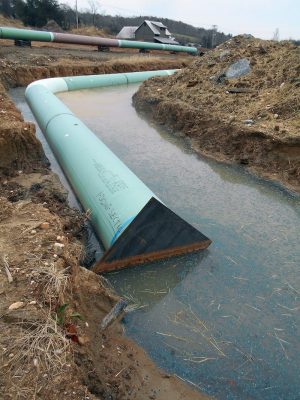
At the time this photo was taken in January 2020, this section of the Mountain Valley Pipeline had been floating in Anne Way Bernard’s field in Franklin County, Va. for more than a year. Photo by Anne Way Bernard
“A lot of the folks coming out were being told things like, ‘If you don’t support this project, you might not have power,’” says Pulliam. “You hear things like, ‘Your AC won’t work if we don’t have more gas coming in.’ It’s just a lot of betrayal to the general trust of the people.”
When people learned more about the project from other locals, he states, some residents who had been for the pipeline started to change their minds.
“Once they see this is actually going against their values, what they consider to be their heritage here, the tables start to turn,” says Pulliam, adding that MVP’s failures on the pipeline mainline have also impacted local sentiment.
On MVP’s mainline in Greenville, West Virginia, Maury Johnson states that he tried to have an open mind about the pipeline at first.

Maury Johnson speaks at a February 2020 public hearing for a bill that would classify a variety of pipeline protests as felonies. Photo by Perry Bennett
“They were supposed to look for the exact center of the pipeline and report anything they saw in the corridor, like springs and wells,” Johnson continues. “They literally walked by a spring on my property and I had to point it out to them. They had to put a GPS marker on it. The very next report to [the Federal Energy Regulatory Commission], they stated that there was no spring within 200 feet of the pipeline.”
When he asked the surveyors about changing the route, they told Johnson that they could not because MVP had to get a permit for each individual stream crossing. Shortly after, Johnson found out that developers planned instead to obtain a Nationwide Permit 12 from the U.S. Army Corps of Engineers, which would grant a blanket water-crossing certification along the entire route.
“I was trying to give them the benefit of the doubt, but they literally misstated facts,” says Johnson.
In Newport, Virginia, Karolyn Givens and her late husband Clarence started fighting the MVP in 2016. The pipeline would cut across their farm and close to their farmhouse, which was built in 1836 and is registered as a state and national historic site.

Karolyn Givens at a pipeline protest rally in Leesburg, Va., in May 2019. Photo courtesy of Karolyn Givens
“My husband became the chair of that group, I became the chair of the sustainability committee.”
The community support from the group was a huge help to Karolyn Givens when her husband passed away.
“They were just amazing — I couldn’t have asked for more support, more care,” says Givens. “Consequently, this yankee really likes small-town Appalachia.”
The pipeline company is offering Karolyn Givens $159,000 to cross the farm they bought for around $550,000. She has not accepted, largely due to the fact that the house is in the pipeline’s blast zone — meaning that if the pipeline were to explode, the house would be destroyed.
“There are huge numbers of communities that are affected by this blast and evacuation zone,” she says. “Not much is said about that.”
Karolyn Givens thought Virginia would stop the pipeline based on the fact that it cut across eight historic sites, but says that she was disappointed in the response from several state agencies including the Virginia Department of Historic Resources.
She states that Mountain Valley representatives have refused to speak with her about the dangers of being in the pipeline’s blast zone. Pipeline explosions have happened in the region before; in 2018, two brand-new pipelines exploded in Pennsylvania and West Virginia. The explosions were attributed to landslides. Similar to the MVP, both pipelines were built on steep slopes.
“Most of the property owners that I know, this is what they have — this is their life savings,” says Karolyn Givens. “This is, in many cases, property that has been passed down to them through generations. And what’s happening is not only are they in the blast zone and evacuation zone, but their property is completely devalued.”
Standing in the Pipeline’s Path
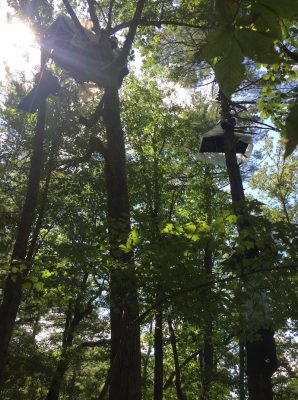
The Yellow Finch tree-sits in Elliston, Va., have been ongoing since September 2018. Photo courtesy of Appalachians Against Pipelines
A demonstration in Montgomery County, Virginia called the Yellow Finch tree-sits celebrated its two-year anniversary on Sept. 5. Since 2018, demonstrators have rotated in and out of several platforms situated about 50 feet above ground in trees that were marked to be cut down for the MVP. Tree-sitters are supported by campers on the ground who provide supplies and keep an eye on pipeline security forces.
On Sept. 15, a judge again delayed a hearing on an injunction by pipeline developers that would allow U.S. Marshals to remove activists from the trees by force. The hearing is now scheduled to take place on Nov. 12. The protest was ongoing as of late October.
Mara Robbins with Preserve Floyd has been involved with ground support on various tree-sits, including Red and Minor Terry’s 34-day tree-sit in the spring of 2018. The mother-daughter pair staged the protest on their Roanoke, Virginia, property where the pipeline was slated to cross.
“It was surreal to be living in the woods for a month in the spring, with three different factions of law enforcement, that we knew of, [monitoring the Terrys] 24/7 for trespassing on their own property,” says Robbins, describing her time on the portion of the Terrys’ land that fell within the pipeline corridor. “That warranted 24-hour surveillance from local police, state police and private security,” she says.
Becky Crabtree in Monroe County, West Virginia, held her own protest in the summer of 2018. On July 31, she parked her Ford Pinto on her property in the path of the MVP.
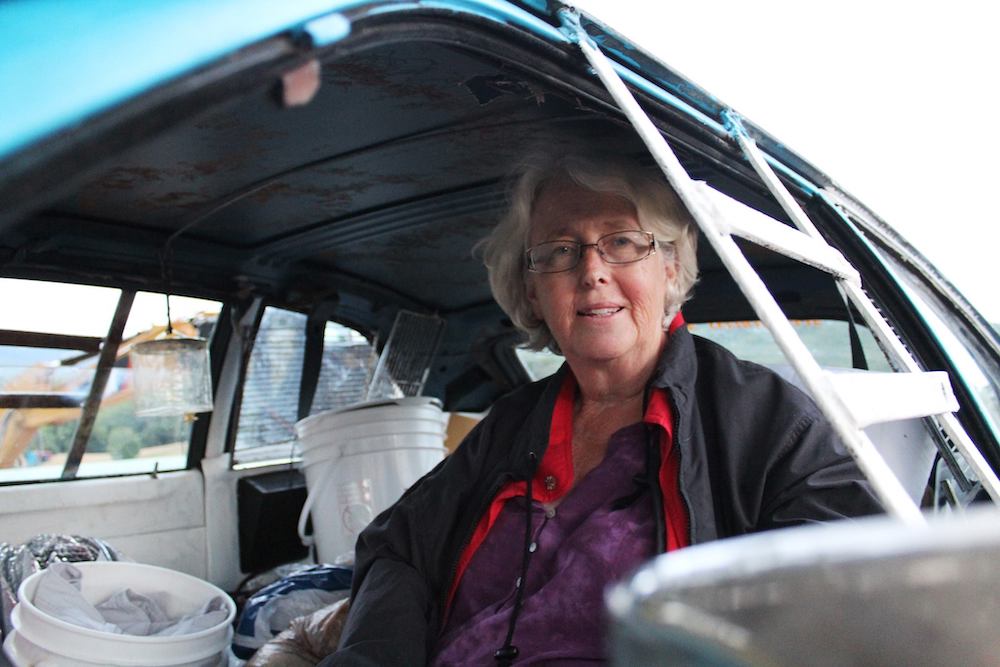
Becky Crabtree blocked Mountain Valley Pipeline construction for several hours in July 2018 by parking her Ford Pinto atop a stack of railroad ties in the construction site. Photo courtesy of Appalachians Against Pipelines
While she was arrested and charged with obstruction, a judge dismissed the charges later that year.
“I’m glad that we did it, we did hold up work for half a day,” says Crabtree.
Defeat of the Atlantic Coast Pipeline
Mara Robbins states that the fight against the MVP has gotten a boost since the Atlantic Coast Pipeline was defeated in July.
“It really is true that we’re stronger together,” says Robbins. “A lot of the minds and hands that were applied to fighting the ACP have joined the fight against the Mountain Valley Pipeline. We have a whole lot more petitions, we have a whole lot more letters to the editor, we have a whole lot more people doing research — there’s more of us to go around.”
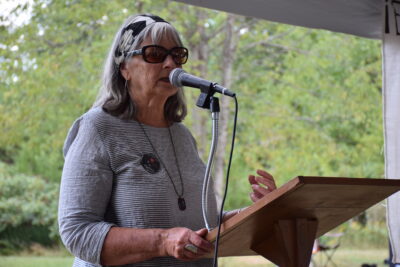
Chad Oba, president of the Friends of Buckingham, speaks at a Union Hill town hall in 2019 on land bought by formerly enslaved people and handed down through the generations. Photo by Cat McCue
When she first heard of the pipeline’s demise, Oba couldn’t believe it was true.
“It’s just starting to sink in,” she says. “Just being in motion for six years fighting this thing, it’s kind of hard, actually, to stop. You’re constantly looking for the next pitfall.”
When Dominion Energy held their first public information meeting about the pipeline in the area in 2014, Oba was there waiting.
“I figured that most people would not have the other side of the story,” says Oba. “I pretty quickly put together a table, sat it outside the meeting, started a sign-up list, and within months, we had incorporated Friends of Buckingham and had a formal organization going.”
Union Hill resident Ella Rose was one of those early attendees. “A neighbor invited me to a church meeting for a new organized group, the Friends of Buckingham, and I learned what this meant for our neighborhood,” says Rose. “The more I learned, the more I realized I had to protect my home and the community. This was especially so when I learned that the location of the compressor station, a very large, noisy, polluting infrastructure, was on land only 150 feet from my front door.”I believe that they picked this location and not the other two they identified [for the compressor station] because they did not think we would speak up or fight back,” Rose continues. “Our lives count too, and we should not be a sacrifice zone for financial interests.”
Oba states that Rose was a quieter person at first.
“The minute she got up to talk, she just kept going,” says Oba. “These amazing relationships and just the growth of people and watching the trust develop over the years has been the rewarding part of this.”
Over the last several years, Rose and Oba have traveled up and down the East Coast, speaking up and raising awareness about Union Hill’s plight.
“It’s made me more courageous to speak up,” says Rose. “Every time I spoke up I was shaking in my boots. But I made it through with the help of my friend, Chad Oba. Chad was my right hand, my right arm.”
Around 100 miles away in Northampton County, North Carolina, Belinda Joyner lives near what would have been the pipeline’s crossing in the county.
“We walked the community, going door-to-door and handing out flyers, talking to the people, informing them about the pipeline,” she says.
Joyner is hardly new to the world of environmental activism.
“I’ve been fighting for the last 20 years, it’s been one thing after another,” she says.
Joyner has helped her community fight back against numerous industrial projects, including a liquid fertilizer plant, a private prison and a coal ash recycling facility. But Northampton activists were unable to stop a $45 million expansion of the nearby Enviva wood pellet plant, which processes logs into wood pellets to be burned for power overseas.
The Northampton compressor station for the ACP would have been sited roughly 5 or 6 miles from the Enviva plant, and added to the plant’s noise and air pollution.
“They just think that they can dump and do whatever they want, and we’re supposed to take it and be happy that it’s here because they claim that it’s going to bring jobs,” says Joyner. “But they don’t tell you what’s going to kill you.”
The victory over the ACP has reinvigorated her.
“It just gives me the strength to know that if you believe and if you fight hard enough and don’t give up, that you can prevail,” says Joyner. “It gives me that extra ‘umph’ to keep fighting, no matter what.”
Desiree Shelley with Mothers Out Front emphasizes that uplifting the environmental justice part of the fight against the ACP contributed to its success. These issues are now at the forefront of the fight against the MVP.
“That’s what got people’s attention and what started to scare investors,” says Shelley. “We’ve learned those lessons from the Atlantic Coast Pipeline, and I think we’re applying them to the Mountain Valley Pipeline.
“I feel that we are winning — and I know that we will win.”
Appalachian Voices does not fund, sponsor or engage in activities such as tree-sits and pipeline blockades.
Editor’s Note: This article was updated on Oct. 30, 2020.
CORRECTION: Oct. 28, 2020
A previous version of this article incorrectly identified a photo of Maury Johnson as being taken in Summers County, W.Va. It was taken in Monroe County, W.Va. The article also incorrectly stated that Becky Crabtree lives in Russ County, W.Va. She lives in Monroe County, W.Va.
Related Articles
Latest News

Leave a comment
Your email address will not be published. Required fields are marked *


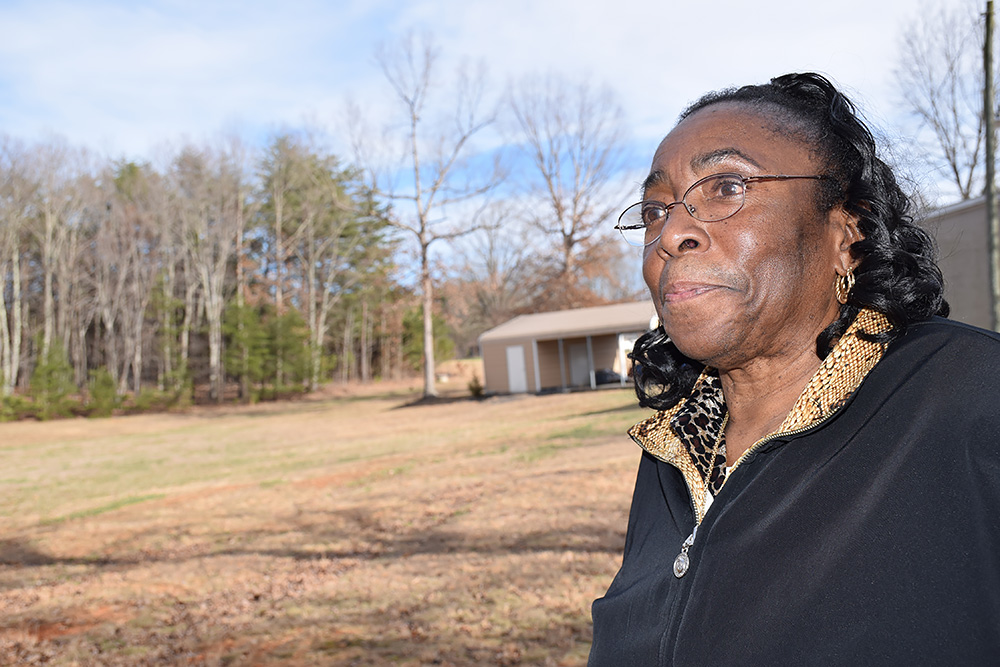



Leave a Comment